Amanda Knox - did she do it?
- Paige Phillips
- Apr 4, 2019
- 14 min read
“If I'm guilty, I'm the ultimate figure to fear, because I'm not the obvious one. But, on the other hand, if I'm innocent, it means that everyone is vulnerable, and that is everyone's nightmare. Either I'm a psychopath in sheep's clothing, or I am you”
– Amanda Knox
Amanda grew up in Seattle, Washington with her three younger sisters. Her mother, Edda, was a mathematics teacher whilst her father, Curt, was the vice president of finance at the local Macy’s store. Amanda’s parents divorced when she was a few years old.

Amanda first visited Italy when she was 15. She visited Roma, Pisa and the Amalfi coast as well as the ruins of Pompeii on a family holiday. Her interested in the country was amplified when she received the book “Under the Tuscan Sun”, which was gifted to her by her mother.
Amanda graduated in 2005 from Seattle Preparatory School and studied Linguistics at the University of Washington, where in 2007 she made the university’s dean’s list. She worked part time jobs in order to fund an academic year in Italy she dreamed of.
At the time, relatives described the 20-year-old as outgoing but unwary. Her stepfather had reservations about her travelling to Italy as he felt she was still too naïve.
Perugia
Amanda moved to Perugia, a city known for its universities and large student population. There had reportedly not been a murder in the city for 20 years, however some of Perugia’s prosecutors has been responsible for Italy’s most controversial murder cases.
In Perugia, Knox shared a four-bedroom, ground-floor apartment in a house known as Via della Pergola 7. Her flatmates were Meredith Kercher, a British exchange student from Coulsdon, Surrey, and two Italian women in their late twenties called Filomena Romanelli and Laure Mezzetti. Both Kercher and Knox moved in on September 10th and September 20th respectively, meeting each other for the first time. Knox worked part-time at a bar called Le Chic, owned by Diya Patrick Lumumba. She told flatmates that she was going to quit because he was not paying her, to which Lumumba denied.

The walk-out semi-basement of the house was rented by 2 young Italian men, both with whom both Kercher and Knox were friendly. One, Giacomo, spent time in the girls’ flat due to a shared interest in music. Returning home at 2am one night in mid-October, Knox, Kercher, Giacomo, and another basement resident met a basketball court acquaintance of the Italians, Ruedy Guede. Guede attached himself to the group and asked about Knox. He was invited into the basement by the Italians, and Kercher and Knox later joined. At 4:30am Kercher left, saying she was going to bed and Knox followed her out. Guede spent the rest of the night in the basement. Knox recalled a second night out with Kercher and Giacomo in which Guede joined them and was allowed into the basement. He was never invited into the women’s apartment.
Three weeks before her death, Kercher went with Knox to the EuroChocolate festival. On October 20th, Kercher became romantically involved with Giacomo, after going to a nightclub with him as part of a small group that included Knox. Guede visited the basement later that day.

On October 25th, Kercher and Knox went to a concert where Knox met Raffaele Sollecito, a 23-year-old student. He was on the verge of completing a computer science degree at Perugia University when he met Amanda. The pair then engaged in a relationship for weeks after. Sollecito said of the relationship “It was a really nice relationship. In that period, she was much more at my apartment than in her one. It was an intense story, it was the start. It was crazy”.

Last sighting of Meredith:
The 1st of November was a public holiday in Italy. Kercher’s Italian flatmates were out of town, as were the occupants of the downstairs flat. That evening, Kercher had dinner with 3 English women at one of their homes. She parted company with a friend at around 8:45pm, about 500 yards from Via Della Pergola 7.
According to Knox’s account, she spent the night with Sollecito and arrived back at her flat on the morning of November 2nd 2007, finding the front door open and drops of blood in the bathroom she shared with Kercher. Kercher’s bedroom door was locked, which Knox took as an indication she was sleeping. Knox showered in the bathroom and as she was exiting, noticed the larger splatter of blood on the bathmat on the floor. She later said “I mean, there’s only a few drops of blood and then there’s that, so maybe someone cut themselves shaving or something like that”.
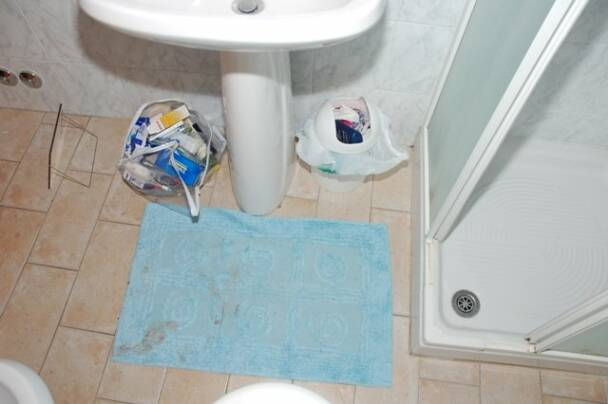
After blow-drying her hair, Knox found faeces in the toilet shared by Romanelli and Mezzetti. Knox said “All of a sudden that gave me the creeps. I felt all of a sudden like someone was in the house with me. I thought ‘Oh shit’”.
Knox went back to Sollecito’s home and later returned with him to Via Della Pergola. Sollecito said “I was surprised [Amanda] took a shower there without having the anxiety of it”. Noticing a broken window in Romanelli’s bedroom and alarmed that Kercher did not answer her door, Sollecito unsuccessfully tried to force the door open. Sollecito called his sister for advice, who urged him to call the 112-emergency number, which he did.
Discovery of the body:
After receiving a concerned phone call from Knox, Romanelli arrived at the flat. She began rummaging around and looking for anything that might be missing, inadvertently disturbing the crime scene. On discovering that the two phones Kercher typically carried with her had been found in a nearby garden, Romanelli became concerned and requested that the police force open the door to Kercher’s bedroom, but the police declined, not believing there was sufficient evidence to damage private property. Instead, Romanelli’s male friend forced the door open at around 1:15pm, with the body of Kercher found inside, lying on the floor, covered by a duvet.

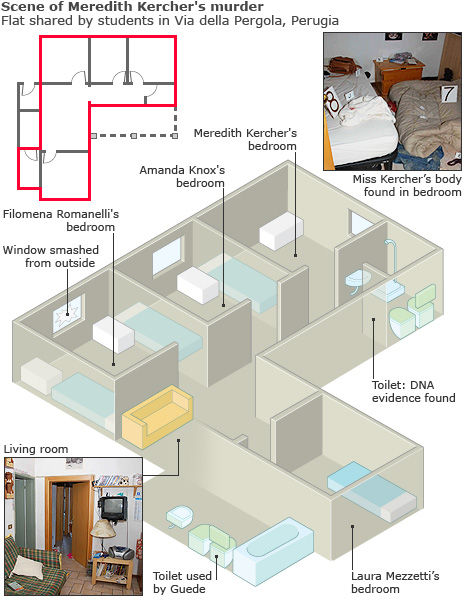
Autopsy of the body:
Kercher’s injuries consisted of 16 bruises and 7 cuts. These included several bruises and a couple of insubstantial cuts on the palm of her hand. Bruises on her nose, nostrils, mouth and underneath her jaw were compatible with a hand being clamped over her mouth and nose. The autopsy was reviewed by a further 3 pathologists, who interpreted the injuries, including some to the genital region, as indicating an attempt to immobilise Kercher during sexual violence.
It was determined Kercher has been stabbed and died from exsanguination due to neck wounds. The level of wounds to her body suggested she was attacked by more than one person.
Investigation:
The first detectives on the scene were Monica Napoleoni and Marco Chiacchiera. Napoleoni conducted the initial interview and quizzed Knox about her failure to immediately raise the alarm, which was later widely seen as an anomalous feature of Knox’s behaviour. According to Knox, Napoleoni was hostile to her from the outset. Chiacchiera discounted the signs of a break-in, deeming them clearly faked by the killer. The policer were not told the extent of Kercher’s relationship with Giaomo in initial interviews. On December 4th, the same day Chiacchiera was quoted as saying that someone known to Kercher and let into the house by her might be responsible for her murder, Guede is believed to have left Perugia.
DNA evidence:
Two crucial pieces of evidence were used to tie Knox and Sollecito to Kercher’s body: a kitchen knife and a bra clasp. The knife was found at Sollecito’s apartment and was touted by the prosecution as allegedly being the murder weapon. It contained Knox’s DNA on the handle and a small amount of Kercher’s DNA on the blade. The bra clasp belonged to Kercher and was found in her bedroom. It contained a trace of Sollecito’s DNA. No other evidence was found linking Sollecito or Knox to the murder.
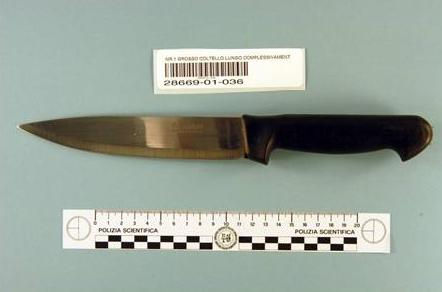
The DNA of Rudy Guede was found in numerous spots throughout Kercher’s bedroom, including mixed with Kercher’s blood in her bag, on a vaginal swab taken from Kercher, and in his bloody handprints and fingerprints throughout the room.
The DNA evidence was later scrutinised in subsequent trials, and was deemed contaminated by forensic experts. In the case of the knife, the amount of Kercher’s DNA present was so minuscule that it could have been disregarded as inconclusive, and an amount that small is almost always the result of contamination. Also, the knife was not examined alone in a sterile environment. Rather, it was examined immediately after the technicians handled and examined 50 items belonging to Kercher that were covered in her DNA.
The bra clasp was not examined until 6 weeks after her murder, and was found about a metre away from its original position. Police procedure at the crime scene in the interim was allegedly not sterile, as there were reportedly people all over the scene without protective suits, and latex gloves were not changed as often as they should have been. It is believed that an investigator could have inadvertently brought some of Sollecito’s DNA from elsewhere in the apartment and transferred it to Kercher’s bedroom. Also, there were at least two other unknown male DNA traces found on Kercher’s bra clasp in addition to Sollecito’s. However, no DNA belonging to Sollecito was found anywhere in the house, except on a single cigarette butt in an ashtray.

An additional piece of evidence used in court was the presence of a mixed bloodstain. Using luminol, a spot in the room of the flatmate whose window had been smashed had been found. Analysis found the blood contained both Knox’s and Kercher’s DNA. This suggests that the murderer must have entered that bedroom after the murder, as someone must have bought Kercher’s blood into the room. Hardly any of Amanda’s DNA was found in her own room, which seemed odd as she would have spent most of her time in there.
Guede’s DNA, mixed with Kerchers, was found on the left sleeve of her bloody sweatshirt and in bloodstains inside her shoulder bag, of which €300 and credit cards had been stolen. Guede’s bloody palm print was also found on a pillow that had been placed under Kercher’s hips.
Knox’s behaviour:
Knox’s exuberant behaviour caught the eye of the police and received massive media attention in the days after Kercher’s murder. She performed cartwheels while waiting to be questioned in a police station, sat on Sollecito’s lap in front of detectives and kissed and caressed him outside the scene of the murder.
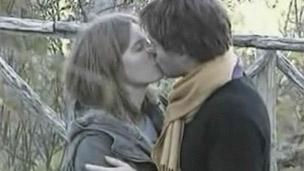
The two were also seen shopping for 'sexy underwear' in a lingerie shop in the Perugia town centre 2 days after the murder.
Sollecito admitted in his book regarding the case that they exhibited “bizarre behaviour”, which gave police reason for suspicion. He admitted that on the night of the murder he and Knox were smoking marijuana, which gave them a foggy memory of the night and didn’t help their alibi.
Knox’s sexuality:
Headlines regarding the case called Knox a ‘femme fatale’ and a ‘man-eater’. A narrative began to develop that Knox was, as she said herself, a “heinous whore, sex obsessed, bestial”.
Giuliano Mignini, the main prosecutor of the investigation, said Knox was “uninhibited” and “bringing boys back home”, whereas Kercher was different, and he believed Kercher scolded Knox for her lack of morals, which caused the two to argue.
Knox was accused of manipulating Sollecito and Guede into raping and killing Meredith.
During her initial imprisonment, Knox was falsely told she was HIV positive and encouraged to make a list of the men she had slept with. These diaries were then leaked to the press, and Knox described as ‘perverted’ and ‘infected’.
Knox questioning:
Over the following days, Knox was repeatedly interviewed as someone who might become a witness. She told police that on November 1st she received a text from Patrick Lumumba advising that her evening waitressing shift was cancelled, and as a result she has stayed over at Sollecito’s apartment. She was not provided with legal counsel, as Italian law only mandates the appointment of a lawyer for someone suspected of a crime. On November 5th, Knox voluntarily went to the police station.
At her trial Knox testified that she had spent hours maintaining her original story, that she had been with Sollecito at his flat all night and had no knowledge of the murder, but a group of police would not believe her. Knox said “I wasn’t just stressed and pressurised, I was manipulated. They were so convinced I was protecting someone. They were saying ‘Who is it? Who is it? Here’s the message on your telephone you wanted to meet up with him, you are a stupid liar’”. Knox also said that a policewoman slapped her numerous times.
Knox said that she had requested a lawyer but was told it would make things worse for her and that she would go to jail for 30 years. She also claimed she was not allowed access to food, water or the bathroom.
Under pressure, Knox falsely stated that she had been in the house when Kercher was killed, and that she thought the murderer was Lumumba (who Knox knew had been serving customers at his bar all that night). Knox, Sollecito, and Lumumba were taken into custody and charged with the murder. Her first meeting with her legal counsel was on November 11th.

Customers who Lumumba had been serving at his bar on the night of the murder gave him a complete alibi. After bloodstained fingerprints of Ruedy Guede were found on bedding under Kercher’s body, Guede was brought from Germany where he had fled. Guede, Knox and Sollecito were then charged with committing the murder together.
Rudy Guede:
Rudy Guede had lived in Perugia since the age of 5 and was raised with the help of his school teachers, a local priest and others. His father returned to the Ivory coast when he was 17, and Guede was adopted by a wealthy Perugia family. Guede said that he had met a couple of the Italian men from the lower level of Via Della Pergola 7 when spending evenings at the basketball court in Piazza Grimana. In mid-2007, his adoptive family asked him to leave their home.
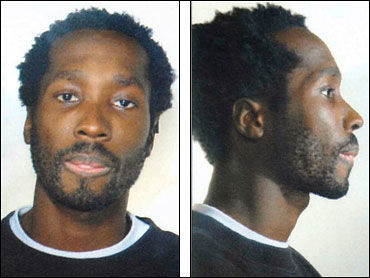
The young men who lived in the downstairs flat at Via Della Pergola 7 were unable to recall how Guede had met them, but they did recall how, after his first visit to their home, they had found him later in the bathroom, sitting asleep on the unflushed toilet, which was full of faeces.
Guede allegedly committed break-ins, including one of a lawyer’s office through a second-floor window, and another during which he burgled a flat and brandished a jack-knife when confronted. On 27thOctober 2007, days before Kercher’s murder, Guede was arrested in Milan after breaking into a nursery school with an 11-inch knife.
Guede went to a friend's house at about 11:30 pm on 1st November 2007, the night of the murder. He later went to a nightclub where he stayed until 4:30 a.m. On the following night, 2nd November 2007, Guede went to the same nightclub with three American female students whom he had met in a bar. He then left Italy for Germany, where he would be located in the subsequent weeks.
In an initial skype conversation whilst he was a fugitive wanted for the murder of Kercher, which Knox and Sollecito were being held for, Guede did not mention Knox or Sollecito as being in the house on the night of the murder. Later his account changed, and he directly implicated them in the murder, which he denied involvement in. In his trial, he did not testify and was not questioned about his statements, which has altered from his original version. Judge Micheli, who led the trial, specified that Guede had not had a knife or stabbed the victim, or stolen any of Kercher’s possessions. Micheli’s finding that Guede must have had an accomplice gave support to the later prosecution of Knox.
In a later statement, Guede said that on the night of November 1st, he and Kercher fooled around, but didn’t have sex, and Kercher complained about Knox. Guede said that he had eaten a kebab that didn’t agree with him and, whilst he was in the bathroom for at least 10 minutes, he heard Knox’s voice and then a scream “louder than the music from my headphones”. He left the bathroom, forgetting to flush the toilet, and said that he saw a man, and he was 101% sure Amanda Knox was there. He never ID’d the man as Sollecito himself, but didn’t disagree with documents saying it was him. After the pair left, Guede said that he went into Kercher’s room and tried to stop the bleeding around her slashed throat with towels, and then he fled out of fear. He said he fled to Germany because that’s’ where the next train was going.
It was later determined that he first went home, washed his hands, changed his clothes and went to a nightclub. And then a pub. The next night, November 2nd, he went out dancing again and then, in the hours of the morning, left for Germany.
Knox and Sollecito conviction:
On December 5th 2009, Knox was convicted on charges of faking a break-in, defamation, sexual violence and murder, as was sentenced to 26 years imprisonment. Sollecito was sentenced to 25 years.
The appeal trial began in November 2010, and on October 3rd 2011, Knox and Sollecito were found not guilty of the murder. In an official statement giving the grounds for the acquittals, Judge Hellmann said Knox had been confused by interviews of "obsessive duration" in a language she was still learning, and forensic evidence did not support the idea that Knox and Sollecito had been present at the murder. On March 26th 2013, the supreme court set aside the acquittals and a retrial was ordered. On March 27th, 2015, the ultimate appeal by Knox and Sollecito was heard by the Supreme Court of Cassation; it ruled that the case was without foundation, thereby definitively acquitting them of the murder.
Rudy Guede conviction:
Guede was sentenced to 30 years in prison for the murder of Meredith Kercher. The sentence was reduced to 16 years upon appeal and later confirmed by Italy’s supreme court.
Guede lied repeatedly through-out the case, modifying his stories based on news reports to best suit his defence.
Evidence against Rudy:
· Guede’s DNA was present in multiple locations in the crime scene, particularly blood stains
· Guede admitted he was with Meredith at the cottage and in the murder room
· In the presence of two attorneys, he admitted having his hands at Meredith’s necks as she died
· Guede said Meredith let him inside the cottage about 8:30pm (30 minute earlier that Meredith’s arrive home at 9pm)
· Guede’s excrement was found in the toilet and his DNA was on the toilet paper
· Guede had cuts on his right hand which were still visible when he was arrested two weeks later
· His shoes prints, set in Meredith’s blood, were found in the murder room and in the hallway
· He told a story about being in the cottage on a date with Meredith when someone else killed her whilst he was in the bathroom – this is a known criminal excuse called ‘the bushy haired stranger’ excuse
Diane Sawyer Interview:
After Knox’s release in 2011, her first interview was with Diane Sawyer, discussing the trial and her release.
Body language experts analysed the cues from the interview to determine if her body language matched up with her verbal message of innocence, and which nonverbal actions were red flags and did not match her statement.
1. Slow blink rate
Throughout the interview, Knox had a noticeably slow blink rate, which is an indicator she is not lying. Deception and high nerves can cause an increased blink rate, so slow blinking matches her statement of innocence.
2. Contempt
Diane Sawyer read out the nicknames the media had given to Knox, such as “she-devil with an angel face.” Knox listened to the names and then said, “I haven’t heard those,” while showing a micro expression of contempt–a one-sided mouth raise. This facial expression of hatred is in congruence with her verbal statement of being wrongly accused.
3. Nods
First, Sawyer asked Knox, “Did you kill Meredith Kercher?” Knox says “No,” very directly, with eye contact, no odd facial tics and, most importantly, a side to side head shake–the nonverbal sign of “no.” This negative head shake matches her negative statement and the absence of facial leaks is also devoid of deception.
Second, Sawyer asks, “Were you there that night?” Knox’s verbal answer is the same, “No.” Yet, her nonverbal behavior at this question is different. She says “No” then flashes a micro expression of surprise and nods her head up and down–the position of “yes.” Here her nonverbal does not match her words. There are a number of reasons why she could have shown that surprise and head nod. Occasionally people raise their eyebrows as a verbal punctuator or exclamation point. It’s not a definitive indicator of lying, but a red flag nonetheless.
4. Swallow
Another red flag came directly following Sawyer’s question about Knox’s whereabouts that evening. Sawyer asked, “Do you know anything else you have not told police, that you have not said in this book?” First, it takes Knox a beat longer to answer this question than previous questions–never a good sign. Then she deeply swallows showing intense nerves. This question would not make an honest person nervous.
Rudy Guede was released from prison at the end of 2018.
for more information go to: http://www.amandaknoxcase.com







Comments